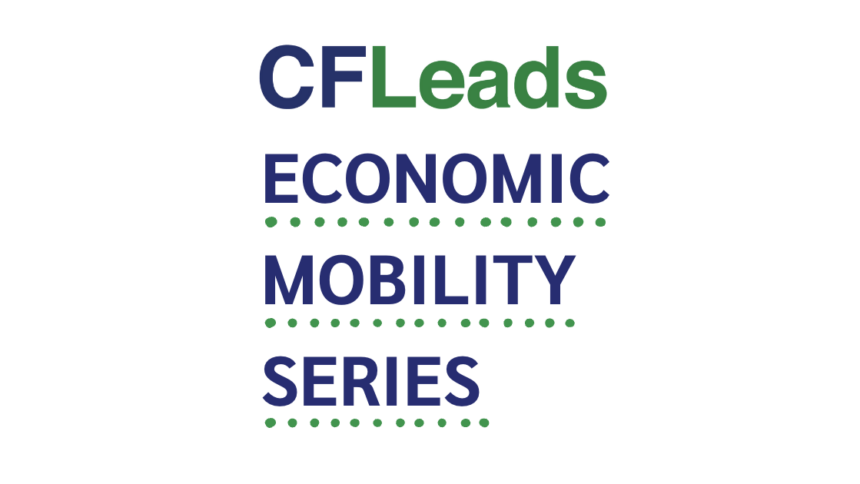Economic Mobility Webinar Series: Powering Change Through Data-Driven Initiatives in Cincinnati, OH
In response to an increased awareness of the role that community foundations play, CFLeads launched a new economic mobility webinar series, featuring community foundations and partners working to advance economic mobility in their communities.
In our second webinar of the series, Powering Change Through Data-Driven Initiatives: Cincinnati’s Innovative Strategy, the Greater Cincinnati Foundation shared how they used data to determine a target population for their grantmaking and how to best measure community impact. The foundation also discussed how to work with board members in understanding systems-level outcomes.
Identifying a Target Population
Committed to seeing all residents thrive in the Greater Cincinnati region, the Greater Cincinnati Foundation (GCF) set out to utilize data to identify a target population for their grantmaking and establish effective methods to measure community impact.
Throughout their work, GCF recognizes the importance of aligning their grantmaking efforts with the specific needs of the community. To determine a target population, the foundation embarked on an extensive data analysis process. The Economic Outlook report, which was funded by GCF’s Women’s Fund, provided initial insights and was specifically disaggregated by race and gender. The report found that Black female workers’ earnings were 36% lower than the median earnings amongst all workers.
We want to see the whole region thrive, and Black women have to be thriving for that to be true”
GCF welcomed conversations with community members and gathered information regarding the challenges they faced. The foundation also prioritized a trust-based approach while learning from and listening to grantees. After analyzing this critical data, GCF identified key social issues prevalent in the region. They discovered areas with the greatest disparities among specific populations, e.g., Black women, allowing the foundation to prioritize their efforts and resources to best serve the community. This data-driven approach enabled GCF to develop a targeted strategy that focused on addressing the root causes of disparities within their grantmaking.
Expecting organizations to make tremendous and deep impact across one year, we just knew was unrealistic for some issues that had existed in our regions historically”
Measuring Community Impact
GCF recognized that measuring community impact is crucial for refining their strategies and ensuring accountability. They understood that their funding initiatives needed to yield tangible results and improve the well-being of their target population. To achieve this, GCF embraced innovative data collection and analysis methods to assess the effectiveness and outcomes of their grantmaking.
To do this, the Greater Cincinnati Foundation:
1. Established robust partnerships with local nonprofits and community organizations.
GCF built a collaborative network that shared a common vision of positive change, e.g., All In Cincinnati. By leveraging the strengths of these partnerships, GCF was able to collect qualitative and quantitative data directly from the communities they served.
2. Adopted a multifaceted approach to measure community impact.
The foundation designed surveys and conducted interviews to gather qualitative data that captured individual stories of transformation and the lived experiences of those benefiting from their grants. Simultaneously, GCF utilized quantitative data, leveraging statistical analysis to measure the extent of change and progress within the target population.
3. Employed ongoing evaluations and feedback mechanisms to ensure continuous improvement.
By monitoring the outcomes of their grantmaking initiatives, GCF adapted their strategies to enhance effectiveness and address any unforeseen challenges. Additionally, GCF actively engaged with their grantees, regularly seeking feedback and cultivating an environment of shared learning and collaboration.
Cincinnati’s Innovative Strategy
The Greater Cincinnati Foundation’s utilization of data to determine a target population for their grantmaking and measure community impact exemplifies their commitment to making a lasting difference in the Greater Cincinnati region. Through extensive data analysis, the foundation was able to identify the populations that need support and focus their efforts on addressing the root causes of disparities. By embracing innovative data collection methods and ongoing evaluation, GCF ensured that their grantmaking initiatives were making a genuine and measurable impact.
GCF’s data-driven approach serves as an inspiring example for philanthropic organizations worldwide. By harnessing the power of data, foundations nation-wide can adopt similar strategies to maximize their impact, create positive change, and forge a brighter future for communities in need. The Greater Cincinnati Foundation’s dedication to being a catalyst for transformation inspires their unwavering commitment to creating a better tomorrow.
We’re looking forward to highlighting more community foundations and partners that are working to advance economic mobility in their communities. Stay tuned for more information about our next webinar in the economic mobility webinar series!




